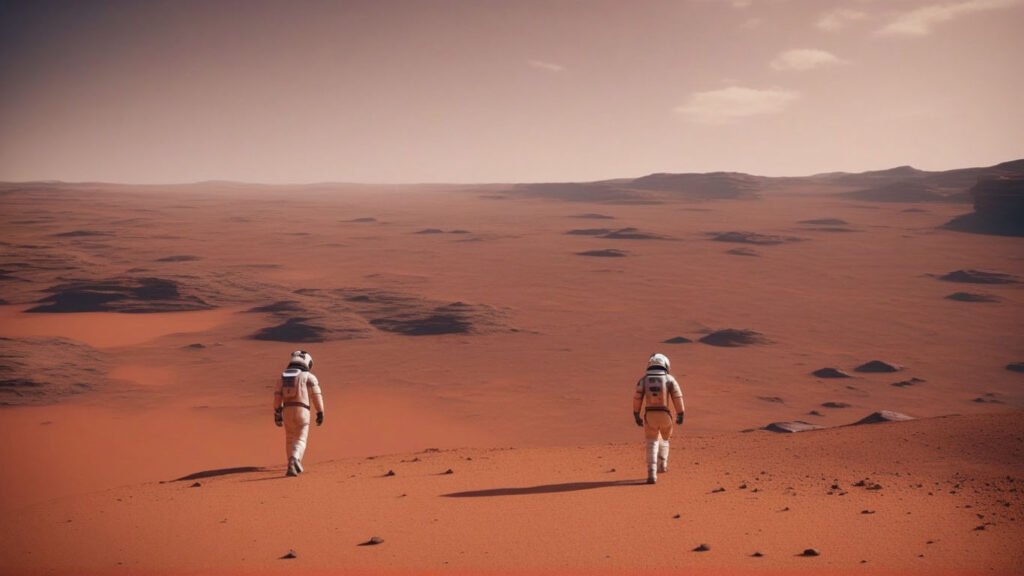Current scientific understanding of the air composition beneath the surface of Mars is based primarily on indirect evidence from various Mars missions, including landers, rovers, and orbital observations. Here’s a summary of the key findings:
1. Atmospheric Composition: The Martian atmosphere, as measured by instruments like those on the Curiosity rover and the Mars Atmosphere and Volatile Evolution (MAVEN) mission, is composed mostly of carbon dioxide (CO₂) (around 95.3%), with nitrogen (N₂) (2.7%), argon (Ar) (1.6%), and trace amounts of oxygen (O₂) (0.13%) and water vapor (H₂O) (0.03%) (Mahaffy et al., 2013).
2. Subsurface Gas Composition: Direct measurements of subsurface gases are limited. However, the presence of certain gases can be inferred from various geological and chemical analyses:
– Methane (CH₄): Trace amounts of methane have been detected in the atmosphere, which suggests that methane could be seeping from subsurface sources (Webster et al., 2018). The origin of this methane, whether biological or geological, remains a subject of active research.
– Water Vapor and Ice: Subsurface water ice has been detected by instruments on orbiters like Mars Odyssey’s Gamma Ray Spectrometer (GRS) and the Mars Reconnaissance Orbiter (MRO). These findings suggest that water, possibly in both ice and vapor form, exists below the surface (Boynton et al., 2002).
3. Soil and Regolith Analysis: The composition of gases in the Martian regolith (soil) has been analyzed by landers and rovers:
– Curiosity Rover: The Sample Analysis at Mars (SAM) instrument suite has analyzed samples drilled from the Martian surface, finding trace gases including oxygen, sulfur compounds, and complex organic molecules. This suggests that the subsurface may contain a mix of gases absorbed or chemically bound in the soil (Ming et al., 2014).
4. Perchlorates and Reactive Chemicals: The Phoenix Mars Lander discovered perchlorates in the Martian soil, which are highly reactive chemicals that can release oxygen when heated (Hecht et al., 2009). This suggests that certain chemical processes in the subsurface might release oxygen.
5. Potential for Trapped Gases: There is speculation that subsurface cavities or porous rocks might trap gases, potentially creating microenvironments with different compositions than the surface atmosphere. However, this is largely hypothetical and would require further direct exploration to confirm.
In conclusion, while the surface atmosphere of Mars is well-characterized, understanding the air composition beneath the surface is still developing. The presence of methane, water ice, and perchlorates hints at a dynamic subsurface environment, but much remains to be explored and understood through future missions and advanced technologies.
References:
– Boynton, W. V., et al. (2002). Distribution of hydrogen in the near surface of Mars: Evidence for subsurface ice deposits. *Science*, 297(5578), 81-85.
– Hecht, M. H., et al. (2009). Detection of perchlorate and the soluble chemistry of Martian soil at the Phoenix lander site. *Science*, 325(5936), 64-67.
– Mahaffy, P. R., et al. (2013). Abundance and isotopic composition of gases in the Martian atmosphere from the Curiosity rover. *Science*, 341(6143), 263-266.
– Ming, D. W., et al. (2014). Volatile and organic compositions of sedimentary rocks in Yellowknife Bay, Gale Crater, Mars. *Science*, 343(6169), 1245267.
– Webster, C. R., et al. (2018). Background levels of methane in Mars’ atmosphere show strong seasonal variations. *Science*, 360(6393), 1093-1096.



